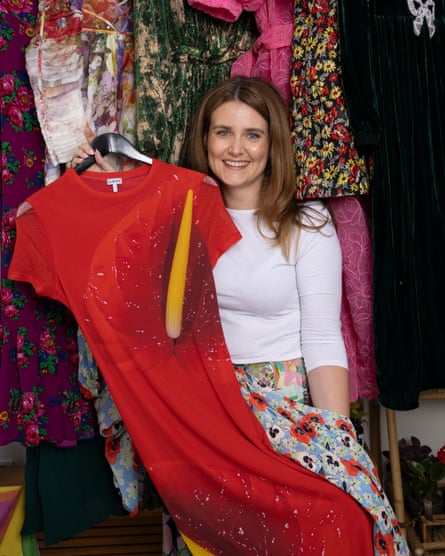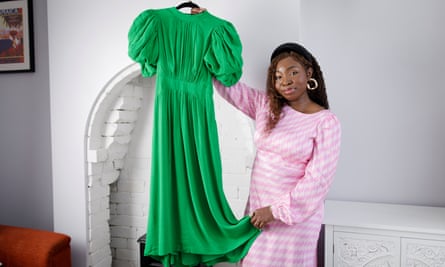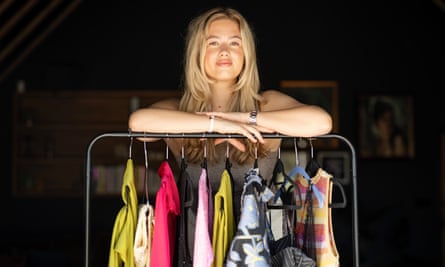
A Burberry dress for £60? A Prada bag for £100? It sounds too good to be true but – thanks to the booming fashion rental market – designer pieces are no longer reserved for those with a six-figure salary.
Experts have dubbed it the “rental revolution”, with GlobalData forecasting that the UK rental apparel market will reach a value of £2.3bn by 2029. In the UK, the biggest players are the website Hurr and the app By Rotation. Both offer peer-to-peer lending, where people borrow clothes directly from one another, usually for a minimum period of three days.
Since launching in 2019, By Rotation has amassed more than 330,000 users and currently lists more than 68,000 items, while Hurr features over 1,600 designer brands. The platform charges the lender commission, typically 10-15%, to host their wardrobe. The lender also arranges the delivery and cleans each piece in between loans. On top of a base fee, the renter pays for the return postage, and both sign an agreement spanning everything from late penalty charges to damage fees.
As the popularity of renting continues to grow, many lenders are buying specifically to rent, scouring designer sales for pieces that they know will appeal and, crucially, earn them a return on their investment. For some, it’s simply a side hustle; for others it has become a full-time job.
Jess Templeton, 35, marketing, Buckinghamshire
The reason I rent my wardrobe is to help save for fertility assistance after my recovery from cervical cancer in 2020. As a result of my fashion side hustle, our journey to becoming parents is going to happen sooner than we thought.
 View image in fullscreen‘As a result of my fashion side hustle, our journey to becoming parents is going to happen sooner than we thought …’ Jess Templeton. Photograph: Graeme Robertson/The Guardian
View image in fullscreen‘As a result of my fashion side hustle, our journey to becoming parents is going to happen sooner than we thought …’ Jess Templeton. Photograph: Graeme Robertson/The Guardian
The first piece I listed on the rental platform Hurr was one of my favourite items from my wardrobe: a green dress with bell sleeves from the French brand Ba&sh. When I wore it myself, women would come up to me in the bathroom to tell me they loved it, so I knew that it had legs for rental. It cost me £191 to buy and I’ve made over £1,000 from renting it out.
It gave me the confidence to start buying pieces specifically to rent. I’m now one of Hurr’s top lenders, making on average £1,000 a month, and even more during the summer season when there are events, such as weddings.
I only buy things I would actually wear – the Y2K trend is huge on rental platforms but I’m not interested in it – and I only buy things in my size. This means that if no one wanted to rent it out, I could still wear it. In May, I bought a Cult Gaia dress costing £338 and have already made a return on investment of 145%.
My latest buy is a Loewe maxidress with a red anthurium print. I first spotted it on the runway, then Rihanna performed in the brand at the Super Bowl, so it’s an iconic piece – that’s really attractive to renters. It shows you know what’s going on in fashion. It retails for £895 but I found it on sale in Selfridges for £537. Hours after I listed it, I had my first booking.
I have a spreadsheet to keep track of everything. I work full-time, so I use a dry cleaning company who come to my doorstep – by now, I know the drivers by name. Most mornings I’ll give them a cup of tea and a biscuit, and have a chat.
Nicola Chote, 35, portfolio manager, Chingford
 View image in fullscreen‘I looked at my wedding dress and thought it was such a shame that it was just going to sit at the back of my wardrobe’ … Nicola Chote. Photograph: Vivian Wan/The Guardian
View image in fullscreen‘I looked at my wedding dress and thought it was such a shame that it was just going to sit at the back of my wardrobe’ … Nicola Chote. Photograph: Vivian Wan/The Guardian
After I got married last August, I looked at my wedding dress and thought it was such a shame that it was going to sit in a dust bag at the back of my wardrobe.
Two months later, I listed it on the rental platform By Rotation. A couple of weeks after that, I was handing it over to my first client. I was petrified and completely questioning myself about what I had done. Although it’s just a piece of clothing, it holds memories of such a special day. But I’ve learned that you’ve just got to have faith in people.
skip past newsletter promotion
Sign up to Fashion Statement
Free weekly newsletter
Style, with substance: what’s really trending this week, a roundup of the best fashion journalism and your wardrobe dilemmas solved
Enter your email address Enter your email address Sign upPrivacy Notice: Newsletters may contain info about charities, online ads, and content funded by outside parties. For more information see our Privacy Policy. We use Google reCaptcha to protect our website and the Google Privacy Policy and Terms of Service apply.
after newsletter promotion
 View image in fullscreenNicola and her husband on their wedding day. Photograph: Rachel Takes Pictures
View image in fullscreenNicola and her husband on their wedding day. Photograph: Rachel Takes Pictures
The dress is by the French-Israeli designer Liz Martinez. I bought it from a bridal boutique in north London for £5,250 and I loan it out for £125 a day for a minimum of three days. Postage is about £30 and dry cleaning is £60, then the platform takes a cut. The final amount isn’t as much as you think it would be but it’s still a nice supplementary income.
Between now and autumn, it will be rented at least once a month. Once someone has messaged me about it, we start to build a rapport. I send them more pictures and chat about the type of wedding they are planning. Lots of brides want to come and try it on first. I completely understand that.
I bought the dress in 2020 when I had been planning to get married in Australia. Then the pandemic hit and my partner and I ended up getting married in London instead. I noticed that the prices for flowers and food have all risen, so I like the idea that I can make a beautiful, high-quality dress accessible to those who might now be on a more constrained budget.
Lydia Epangué, 35, project manager, Birmingham
 View image in fullscreen‘With bills continuing to rise, it’s become a really great side hustle’ … Lydia with her dress from Rotate. Photograph: Andrew Fox/The Guardian
View image in fullscreen‘With bills continuing to rise, it’s become a really great side hustle’ … Lydia with her dress from Rotate. Photograph: Andrew Fox/The Guardian
I was buying dresses that I never wore, so they would just sit in my wardrobe. The first piece I listed for rent was a puff-sleeved green dress from the Danish brand Rotate. Straight away, it was a huge hit. It’s very eye-catching and people love the colour. I bought it for £290 and, to rent it, I charge £10 a day for a minimum of three days. Then I add £15 for dry-cleaning and £10 for the postage. The rental platform takes a cut, but even after that, it’s worth it. I bought a couple of discounted Aje dresses recently – I’ve already had 10 bookings for them, so I’ll make about £500 straight away.
Of course, clothes get damaged. It’s one of the biggest downsides to renting. The worst was when the Rotate dress came back with a huge bleach stain across the front of it. Luckily, I have an amazing seamstress who was able to create a pleat to hide it. The renter claimed she didn’t cause it and we eventually came to an agreement where we split the cost of the repair.
I always tell people: if you are really precious about a certain piece then don’t rent it out. I don’t lend anything with sequins or clothes made from a delicate fabric and when I shop for pieces to lend out, I think about how durable they are. They are going to be worn multiple times, by multiple people, and cleaned a lot. Some fabrics lose their colour quickly due to all the washing.
I work full-time and have two kids. When I first started lending, I thought I would use the extra money to treat myself but, with bills continuing to rise, it’s become a really great side hustle.
Rubie Drake, 21, events manager, Essex
 View image in fullscreen‘Renting means you can get something that’s a bit more luxurious’ … Rubie Drake. Photograph: Linda Nylind/The Guardian
View image in fullscreen‘Renting means you can get something that’s a bit more luxurious’ … Rubie Drake. Photograph: Linda Nylind/The Guardian
Last year, all my friends at university were saving up to buy the same one-shoulder mini dress from Rat & Boa – a British brand that’s really popular on Instagram. The dress usually retails for £200, but I spotted one on eBay for £80. I wanted to make some extra money so I thought, why not buy it specifically to lend it out? I had seen a TikTok video from someone who had rented successfully, so I thought I’d give it a go.
Since then, that dress has been rented more than 25 times – someone rents it out at least once a week. Due to demand, I’ve bought another three of the same dress in medium, small and extra small. I’ve invested in some other brands, too, and now make about £250 a week from renting.
I use a rental platform but I have also set up an Instagram account so I can lend independently. I post pictures of what’s available and people message me if they see something they want to rent. It is more of a risk – unlike the rental platforms, I don’t have insurance, so I usually lend to friends of friends.
Most of my clients are graduates, like me. A lot of people see clothes as disposable, so renting is a good alternative. Since I left uni, I no longer rent to students because the last time I did a girl ripped the front of the dress I had loaned her. She messaged me to apologise, but it couldn’t be repaired so she ended up paying the cost price.
Now I’ve got a full-time job in event management, I have to be really organised about renting out my wardrobe. In between loans, I send each piece to be dry-cleaned. Some of my dresses can only be hand-washed, so often my mum does that for me while I’m at work. Dresses seem to be the items that are most in demand – I think it’s because people rent more for special occasions. It means you can get something that’s a bit more luxurious, and decreases the chance that somebody else will be wearing the same dress, as most people shop the high street owing to cost.
